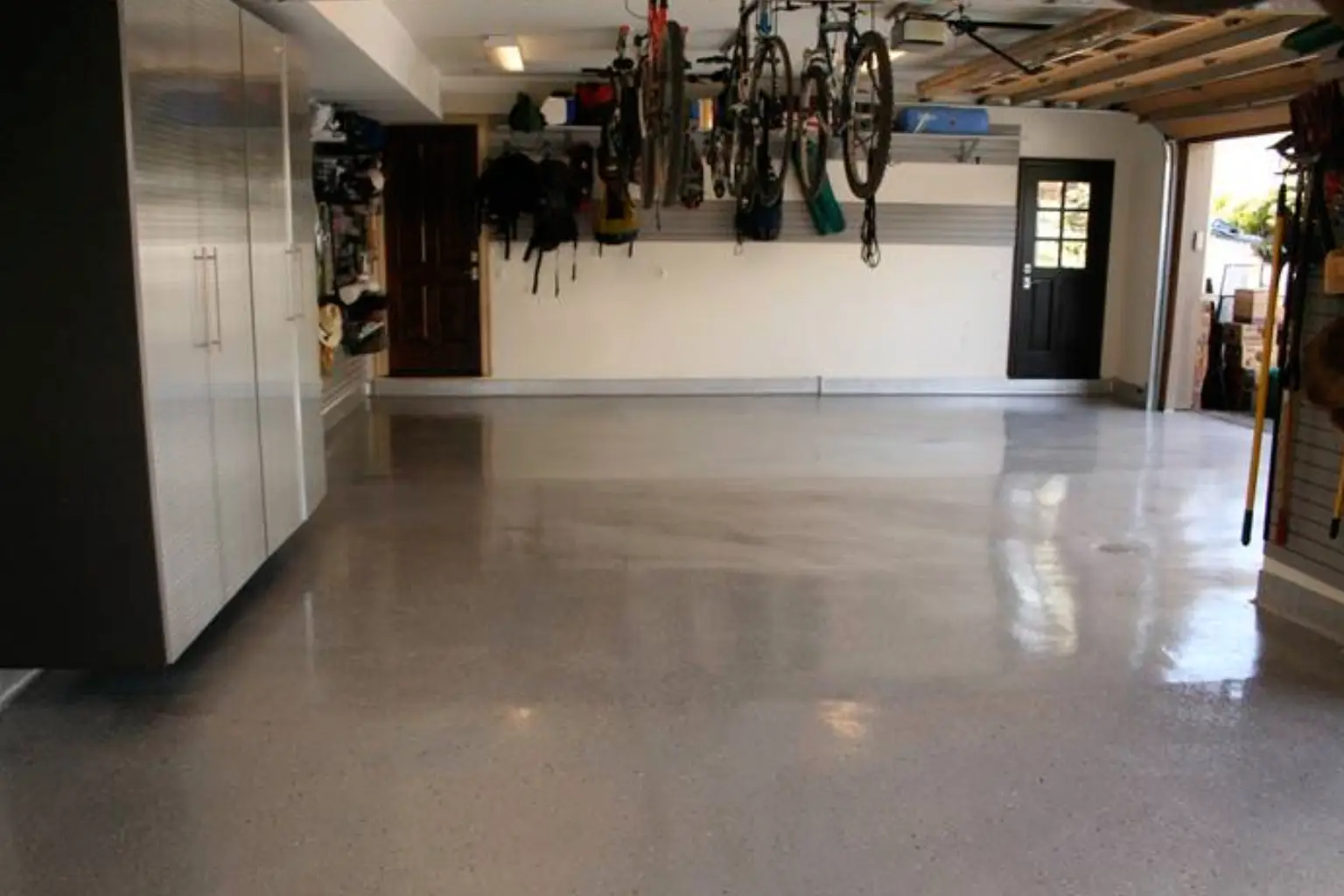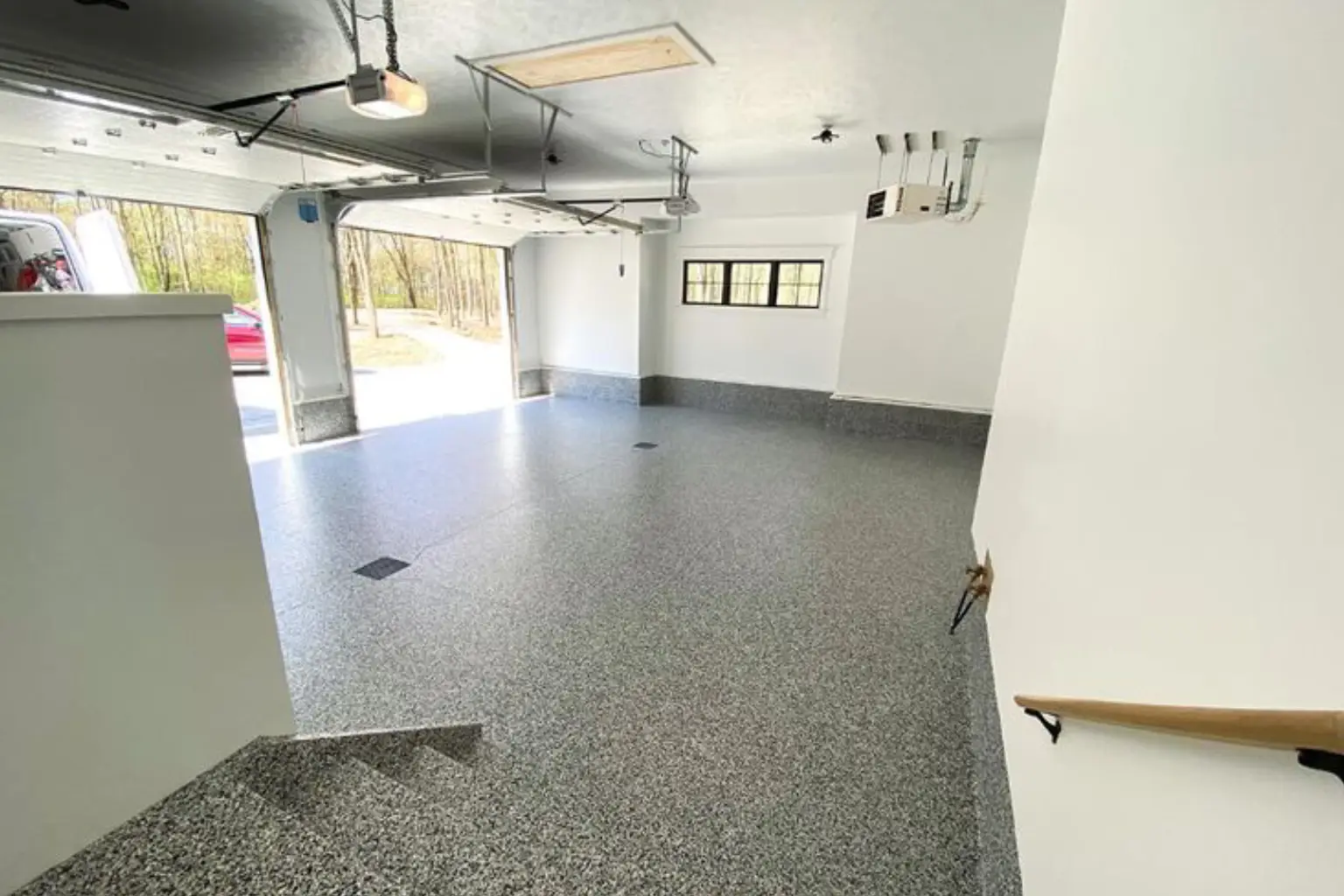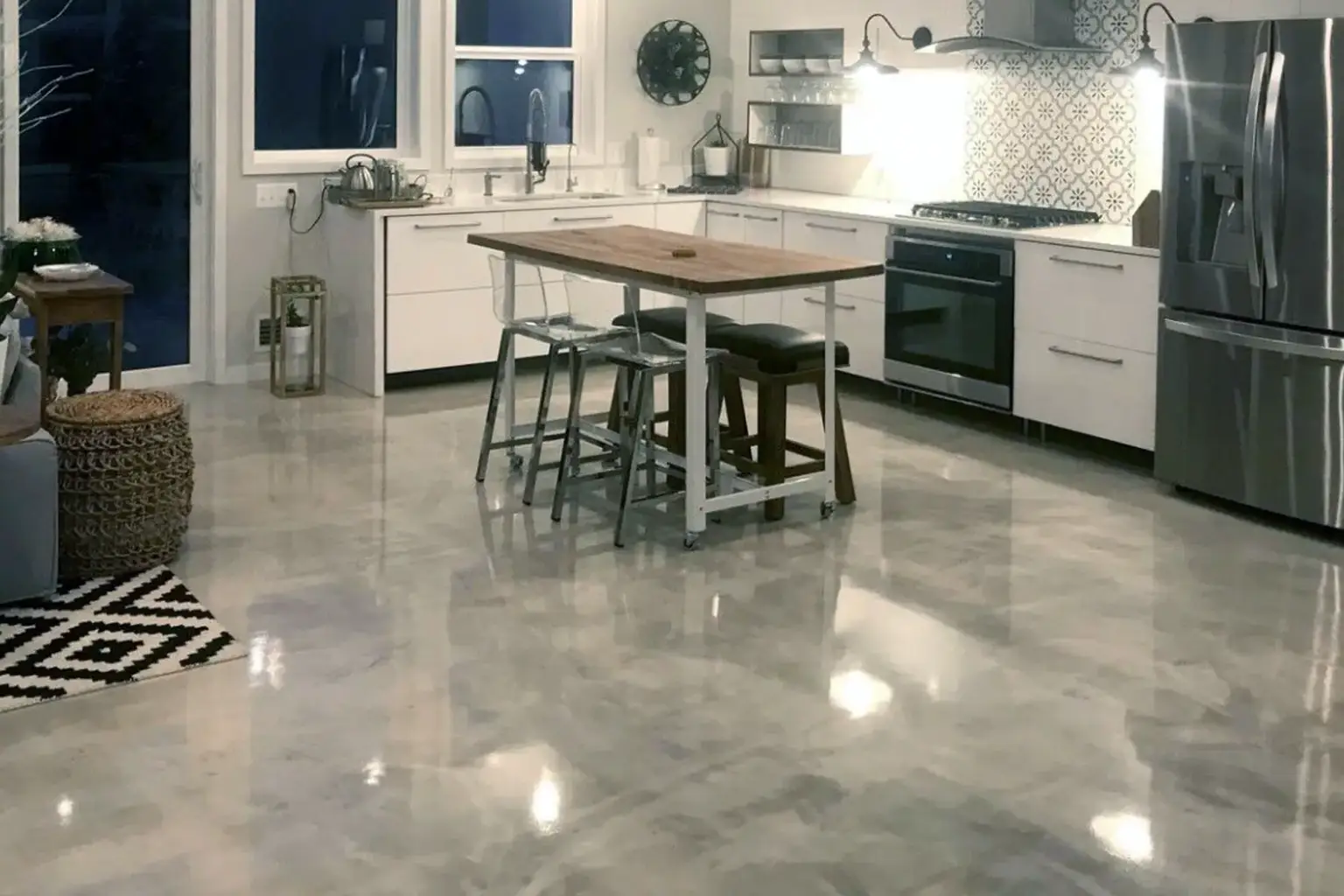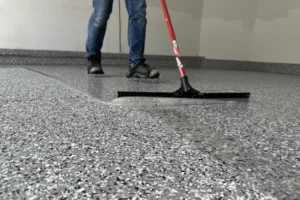If you’re planning to upgrade your floors with a durable, glossy, and long-lasting coating, polyaspartic is one of the top options to consider. It has earned a strong reputation for its quick curing time, excellent UV resistance, and impressive durability, making it a reliable choice for garages, basements, patios, and commercial spaces alike. But before moving forward, most people want a clear answer to the same question: What is the polyaspartic floor coating cost?
Because pricing can vary based on the size of your space, the condition of the concrete, the level of surface preparation needed, and the type of finish you choose, having a detailed cost breakdown is essential. This guide explains every major cost factor, typical price ranges, and what affects the final quote, helping you estimate your budget more accurately and decide whether polyaspartic flooring is the right fit for your project.
What Is the Average Polyaspartic Flooring Cost?
The first thing everyone wants to know is the actual price. On average, the cost of polyaspartic flooring in 2025 usually ranges from:
- $6 to $12 per square foot for standard residential applications
- $9 to $16 per square foot for commercial settings
- Higher-end custom installs may reach $18+ per square foot
This makes polyaspartic slightly more expensive than traditional epoxy, but the performance difference often makes the upgrade worth it. The coating is stronger, more flexible, UV-stable, and cures within hours, which means less downtime.
If you’re comparing, think of it this way:
- Basic epoxy = lower upfront cost
- Polyaspartic = higher durability + faster return to use
When you consider lifespan and maintenance, polyaspartic often becomes the more cost-effective long-term investment.
Polyaspartic Floor Coating Cost per Square Foot
One of the easiest ways to estimate a flooring project is by looking at the polyaspartic floor cost per square foot. This metric allows homeowners and business owners to quickly gauge the total investment based on their space size. On average, residential installations range from $6 to $12 per square foot, while commercial and retail projects usually cost between $9 and $16 per square foot. High-end or decorative applications, including metallic finishes or multi-layer flake systems, can push costs to $18 or more per square foot.
Several factors influence the polyaspartic floor coating cost per square foot:
- Concrete Condition: Smooth, new concrete is cheaper to coat, while old, cracked, or uneven surfaces require extensive prep work.
- Thickness of Coats: Thicker coatings improve durability but increase material and labor costs.
- Decorative Additives: Flakes, pigments, and metallic effects raise both material costs and installation time.
- Surface Prep and Primers: Grinding, concrete repair, or moisture barriers add to labor and materials.
While it may seem that polyaspartic flooring cost per square foot is higher than traditional epoxy, the durability, UV resistance, and long-lasting finish make it a better long-term investment. Spending a little more upfront often saves money on repairs, replacements, and downtime over the life of the floor.
Applications of Polyaspartic Floors
Polyaspartic flooring is one of the most versatile flooring options available, but the polyaspartic floor coating cost can vary widely depending on where it’s installed. Residential, commercial, retail, and industrial spaces all have different requirements for durability, surface preparation, and finishes, and each of these factors directly affects pricing.

Residential Polyaspartic Flooring
For homeowners, polyaspartic in residential flooring is a popular choice for garages, basements, patios, and entryways because it combines durability with a clean, polished look. The polyaspartic floor cost per square foot in residential settings is generally lower than commercial or industrial installations, mainly because the floors usually need less prep and fewer thick coats.
Common factors affecting residential pricing include minor crack repairs, optional moisture barriers, and standard flake or solid color finishes.
The upfront cost may be slightly higher than epoxy, but the long lifespan, UV resistance, and low maintenance make it a cost-effective option over time. Homeowners save both money and effort since these floors don’t require frequent repairs or refinishing.
Industrial Polyaspartic Flooring
Industrial polyaspartic flooring is built to handle heavy machinery, constant foot traffic, chemical exposure, and extreme temperatures. Warehouses, factories, and workshops demand thicker coatings, high-performance primers, and extensive surface prep.
All of these requirements naturally increase the polyaspartic flooring cost. The main cost drivers include concrete grinding, multiple coating layers, abrasion and chemical resistance, and larger square footage.
Despite the higher upfront cost, industrial floors offer significant long-term savings. They reduce downtime, require minimal maintenance, and last longer than traditional epoxy or polyurethane, making them a practical investment for high-stress industrial environments.
Commercial Polyaspartic Flooring
Commercial spaces, like clinics, offices, restaurants, and showrooms, need flooring that can handle heavy daily use while maintaining a professional appearance. Commercial polyaspartic flooring sits between residential and industrial pricing, as the cost depends on traffic levels, prep work, and the finishes chosen.
Factors that affect the polyaspartic floor coating cost include decorative flakes or metallic patterns, mid-range build thickness, slip-resistant additives, and hygiene-focused topcoats. The fast curing time is another advantage, as it reduces downtime for businesses, which is a hidden cost saving.
Over time, commercial polyaspartic floors remain durable, easy to clean, and visually appealing, making the investment worthwhile.
Retail Polyaspartic Flooring
Retail spaces experience some of the heaviest daily foot traffic, so retail polyaspartic flooring must be both strong and visually attractive. The polyaspartic floor cost per square foot for retail installations usually ranges from $9 to $16, depending on the size of the store, the type of surface preparation needed, and whether decorative finishes or safety coatings are added.
Key factors influencing cost include high-traffic zones that need thicker coats, decorative flake patterns to enhance the store’s appearance, and slip-resistant topcoats for customer safety.
Retail floors may have a higher upfront cost than residential installations, the long-term benefits are considerable: reduced maintenance, minimal downtime, and a durable surface that stays attractive for years, ensuring the space is both functional and inviting.
Factors That Increase the Cost of Polyaspartic Floor Coatings
Several factors can significantly increase the polyaspartic floor coating cost. Knowing these details helps you plan your budget accurately and avoid unexpected expenses.
Concrete Condition
The state of your existing concrete plays a major role in pricing. Old, cracked, or uneven concrete requires extensive preparation, such as grinding, patching, and leveling, before the polyaspartic coating can be applied. The more work needed to make the surface smooth and stable, the higher the polyaspartic flooring cost per square foot. Homes with newer, well-maintained concrete generally fall on the lower end of the price range.
Moisture Issues
Concrete naturally absorbs moisture over time. If your slab is damp or has a high moisture content, it can prevent the polyaspartic coating from adhering properly. Installing a moisture barrier or specialized primer is necessary in such cases. These additional materials and labor increase the cost of polyaspartic flooring, but they are essential for preventing peeling, bubbling, or long-term damage.
Decorative Upgrades
Adding aesthetic features, like metallic pigments, colored flakes, quartz blends, or custom designs, enhances the floor’s appearance but also raises costs. Decorative additives require additional material, longer application time, and skilled labor. The polyaspartic floor coating cost increases accordingly, but these upgrades often make your floor more visually appealing and can increase the overall value of your property.
Coating Thickness
Thicker polyaspartic layers provide better durability, higher chemical and abrasion resistance, and longer lifespan. However, more material means a higher polyaspartic floor cost per square foot. Standard residential floors may need only one or two coats, while commercial and industrial floors often require thicker builds for heavy traffic, which raises the price.
Old Coating Removal
If your concrete already has an existing coating, like epoxy, paint, or sealant, it usually needs to be stripped before installing polyaspartic flooring. This removal process requires special equipment, labor, and disposal, which can significantly increase the polyaspartic flooring cost. Skipping this step isn’t recommended, as it can lead to adhesion problems and reduce the lifespan of the new coating.
Material Cost Breakdown: What You’re Paying For
When calculating the polyaspartic floor coating cost, it’s important to understand exactly what contributes to the final price. The material itself is a high-performance resin designed for fast curing, excellent durability, and UV stability. Beyond the base resin, several components affect the overall cost:
- Primers: Primers are applied to the concrete before the polyaspartic coating to ensure proper bonding. They help seal the surface, prevent adhesion problems, and make the coating last longer. Floors without primer may have issues like peeling or bubbling, so including a quality primer adds to the polyaspartic flooring cost but ensures a smooth, durable finish.
- Decorative Additives: Many homeowners and businesses choose decorative flakes, metallic pigments, or quartz blends to enhance the floor’s visual appeal. These materials add texture, color, and depth to the finish, creating a premium look. Decorative additives increase material costs and require more precise labor for even distribution, contributing to a higher polyaspartic floor coating cost, but they also add style and property value.
- Topcoats: Topcoats are the protective layer applied over the polyaspartic base and decorative elements. They provide stain resistance, UV protection, and a glossy finish that keeps the floor looking fresh for years. High-quality topcoats slightly raise the polyaspartic flooring cost per square foot, but they prevent damage from everyday use, chemical spills, and sunlight, which reduces long-term maintenance expenses.
- Optional Materials: Depending on the condition of your concrete, extra materials like crack fillers, moisture barriers, and texture additives may be necessary. Crack fillers repair imperfections, moisture barriers prevent adhesion issues on damp slabs, and texture additives improve slip resistance. While these extras increase the upfront cost of polyaspartic flooring, they are essential for achieving a safe, durable, and long-lasting surface.
Polyaspartic Garage Floor Cost
Garages are among the most common spaces for installing polyaspartic flooring because they require durability, chemical resistance, and a polished, professional appearance. Understanding the polyaspartic garage floor cost is essential for homeowners to plan their budget and ensure they get the best value for their investment. Costs vary based on the garage size, the condition of the concrete, and any decorative or protective finishes chosen.

Here’s a general estimate based on garage size:
- 1-Car Garage (Approx. 250 sq. ft.): $1,800 – $2,800
A single-car garage is the most affordable option. The price covers basic surface prep, primer, a standard polyaspartic coating, and a protective topcoat. Additional decorative options, such as flakes or custom colors, can increase the price slightly. - 2-Car Garage (Approx. 400–450 sq. ft.): $2,800 – $5,000
For a standard two-car garage, costs rise due to the larger area and more material required. Surface preparation may include crack repairs, leveling, and optional moisture barriers. Decorative finishes or slip-resistant coatings also add to the total polyaspartic flooring cost. - 3-Car Garage (Approx. 600+ sq. ft.): $4,500 – $8,000
Larger garages require more materials and labor, which naturally increases the polyaspartic floor cost per square foot. Extensive prep work, such as grinding, patching, and applying thicker coatings, may be necessary for durability. Decorative options or high-end finishes can further increase the total investment.
How to Estimate the Total Cost of Polyaspartic Flooring for Your Project
Estimating the total cost of polyaspartic flooring requires considering multiple factors beyond just the per-square-foot price. Start by measuring your space accurately, including any irregular areas that may require extra material or labor. Multiply the area by the polyaspartic floor cost per square foot, which ranges from $6 to $18, depending on whether it’s residential, commercial, or industrial.
Next, factor in surface preparation costs. Concrete may need grinding, leveling, crack repair, or a moisture barrier, which can add several dollars per square foot. Decorative finishes, such as flakes or metallic pigments, and thicker coatings for durability, will further increase costs.
Finally, consider labor, regional pricing variations, and any additional safety features like slip-resistant topcoats. By adding all these elements together, you can arrive at a realistic overall polyaspartic flooring cost for your project.
Factors That Reduce the Cost of Polyaspartic Flooring
Several elements can increase the polyaspartic floor cost, there are also ways to keep your project budget-friendly without compromising quality. Being aware of these factors helps homeowners and business owners save money while still getting a durable, long-lasting floor.
1. Good Concrete Condition
If your concrete is already smooth, level, and free of cracks or moisture issues, preparation work is minimal. This reduces both labor and material costs, lowering the overall polyaspartic flooring cost per square foot. Newer homes or well-maintained commercial spaces often benefit from this, making installation faster and cheaper.
2. Simpler Finishes and Designs
Choosing basic solid colors or standard flake blends instead of metallic or custom decorative options can significantly reduce the polyaspartic floor coating cost. Fewer layers of pigment or decorative materials mean less material cost and shorter installation time, making your project more affordable.
3. Larger Project Areas
Many contractors offer lower per-square-foot pricing for larger installations because the setup time and equipment costs are spread across more surface area. This means that bigger garages, basements, or commercial spaces may actually cost less per square foot than smaller rooms.
4. Minimal Surface Prep
Projects with minimal grinding, crack repair, or leveling work are naturally less expensive. If your concrete is already in good shape, you’ll save on labor and materials required for extensive preparation, reducing the overall polyaspartic flooring cost.
5. Off-Season or Local Contractor Discounts
Scheduling your polyaspartic floor installation during slower periods or working with local contractors can help reduce labor and travel costs. These small savings can make a noticeable difference in your total cost of polyaspartic flooring, especially for larger spaces.
By paying attention to these factors, you can achieve a high-quality polyaspartic floor while controlling costs, making the investment more practical for your home or business.
Cost of Polyaspartic Flooring vs. Epoxy vs. Polyurethane
When planning a flooring project, many homeowners and business owners wonder which option offers the best value: polyaspartic, epoxy, or polyurethane. Comparing the polyaspartic flooring cost with these alternatives can help you make an informed decision based on both upfront price and long-term benefits.
Polyaspartic Flooring
The polyaspartic floor cost per square foot usually ranges from $6 to $18, depending on the application, thickness, and decorative finishes. Polyaspartic is known for its:
- Fast curing (often ready in hours, not days)
- High UV resistance (won’t yellow over time)
- Exceptional durability and flexibility
- Low maintenance requirements
The initial investment is higher than epoxy or polyurethane, but the long-term value is significant. Polyaspartic floors require fewer repairs, last longer, and maintain their glossy appearance for years, making them cost-effective over time.
Epoxy Flooring
Epoxy is one of the most common alternatives due to its lower upfront cost, typically ranging from $3 to $8 per square foot for standard residential installations. It provides a durable, smooth finish suitable for garages, basements, and commercial spaces.
However, epoxy has limitations that can increase long-term expenses:
- Longer curing times (often 24–72 hours) can delay space use
- Less UV stability (prone to yellowing in sunlight)
- Lower flexibility, making it more likely to crack under stress
Because of these factors, the overall cost of epoxy flooring may rise over time due to repairs and maintenance, especially in high-traffic or industrial areas.
Polyurethane Flooring
Polyurethane floors fall somewhere between epoxy and polyaspartic in price, usually $5 to $12 per square foot. They offer better UV resistance and flexibility than epoxy, making them suitable for commercial or retail spaces exposed to sunlight or temperature changes.
However, polyurethane usually has a slower cure time than polyaspartic, which can increase downtime and labor costs. While it’s more affordable upfront than polyaspartic, it may require more frequent maintenance or recoating, which can affect its long-term cost-effectiveness.
Polyaspartic flooring cost is higher initially, but its combination of fast curing, UV resistance, and long-lasting durability often makes it the most cost-effective option over time. Epoxy is cheaper upfront but can cost more in maintenance, and polyurethane sits in the middle with moderate upfront cost and moderate maintenance.
For homeowners and business owners looking for longevity, reduced downtime, and minimal upkeep, polyaspartic is usually the smarter investment.
| Type | Average Cost per Sq. Ft. | Lifespan | UV Resistance |
| Epoxy | $3–$7 | 3–5 years | Poor |
| Polyurethane | $5–$9 | 5–7 years | Good |
| Polyaspartic | $6–$16 | 10–15+ years | Excellent |
Maintenance Costs and Long-Term Value
One of the main advantages of polyaspartic flooring is its low maintenance and long-term value. Unlike epoxy or polyurethane, polyaspartic flooring cost is balanced by minimal upkeep. Regular cleaning involves sweeping or mopping with mild detergents, with no need for waxing, resealing, or frequent repairs.
Over time, polyaspartic’s UV resistance, chemical resistance, and flexibility prevent fading, cracking, and peeling, reducing replacement or repair expenses. This long-term durability makes it especially cost-effective for garages, commercial areas, and industrial spaces where heavy use is expected.
Even though the initial cost of polyaspartic flooring may be higher than other options, the savings on maintenance, repairs, and downtime often make it the smarter investment for both homes and businesses.
Conclusion
The cost of polyaspartic flooring varies based on space type, surface condition, decorative options, and application requirements. Residential installations range from $6 to $12 per square foot, while commercial and industrial spaces may cost $9 to $18+ per square foot.
The initial investment is higher than epoxy or polyurethane, but the polyaspartic long-term benefits fast curing, UV resistance, low maintenance, and exceptional durability make it a smart choice for homeowners and business owners alike. By knowing all the factors that affect polyaspartic floor coating cost, you can budget confidently and choose Epoxy Shine for a flooring solution that delivers value, performance, and lasting appeal.
FAQs About Polyaspartic Flooring Cost
What is the average polyaspartic floor coating cost?
The polyaspartic floor coating cost typically ranges from $6 to $18 per square foot, depending on application, thickness, decorative finishes, and surface preparation. Residential floors are usually less expensive than commercial or industrial installations.
How much does a polyaspartic garage floor cost?
A standard 2-car garage usually costs between $2,800 and $5,000, depending on surface prep, decorative options, and coating thickness. Heavy-duty or custom finishes can increase the polyaspartic garage floor cost.
How is the cost of polyaspartic flooring calculated?
The cost of polyaspartic flooring is calculated by multiplying the area in square feet by the polyaspartic floor cost per square foot, plus additional costs for surface prep, primers, topcoats, and decorative additives.
Is polyaspartic flooring more expensive than epoxy or polyurethane?
Yes, polyaspartic flooring cost is higher upfront than epoxy or polyurethane, but it lasts longer, cures faster, resists UV damage, and requires minimal maintenance, making it a more cost-effective option in the long run.
Can maintenance affect the total cost of polyaspartic flooring?
Absolutely. Minimal maintenance is required for polyaspartic floors, which reduces repair and replacement costs over time. This means the overall cost of polyaspartic flooring is often lower than it seems when considering long-term durability.







